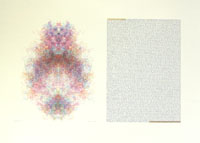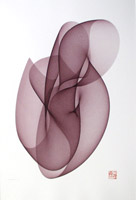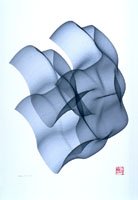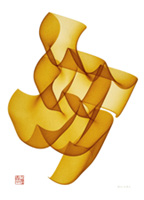|
<< Archive Menu | History | Main Menu | Search | Contact |
|||
| Documentation
for Roman Verostko's participation
algorithmic drawings |
|
||
 |
The
Manchester Illuminated Universal Turing Machine, 22" by 29",
1998. Algorithmic pen and ink drawing with gold leaf
enhancement. The binary number is the code for a Universal Turing
Machine (UTM). This version, in expanded binary, is quoted from Chapter
2 in The Emperors New Mind by Roger Penrose.
The Project: This is one of a family of algorithmic pen plotted drawings presented as illuminations of the Universal Turing Machine code. These drawings, reminiscent of medieval manuscript illuminations, celebrate Alan Turing's historic work with universal problem solver procedures. They were created especially for the Manchester-Liverpool context as homage to Alan on the 50th anniversary of his historic work in Manchester. Thirteen from this family were exhibited in Manchester (UK) on the occasion of the Ninth International Symposium on Electronic Art (1998). Executed on hot pressed Arches, each piece includes a burnished gold leaf enhancement. |
||
 |
Cyberflower IV, Algorithmic pen & ink drawing, 2000. 23" by 30". The cyberflower series demonstrates that a new frontier of form emerges for artists who create original form generators | ||
 |
Cyberflower I, Algorithmic pen & ink drawing, 2000. 23" by 30". | ||
 |
Cyberflower V, Algorithmic pen & ink drawing, 2000. 23" by 30". | ||
|
Display Case
|
Derivation of the Laws. . ., by George Boole with algorithmic illustrations by Roman Verostko, a limited edition, Minneapolis, 1990. Display. Display shows 3 original books from the limited edition of The Derivation of the Laws by George Boole. Two books are opened to show the pen and ink drawings that were made individually and tipped in as frontispieces for each book. The 3rd book shows a text page with an illustration achieved with line cut plates made from algorithmic drawings. Text. The text is Chapter III from Boole's Classic work, An Investigation of the Laws of Thought.. (Macmillan, London, 1854). This edition includes a Preface by Roger Malina, a statement by Roman and a Postscript. Frontispieces. For
this edition 125 original front and end-pieces were created in the
artist's studio. Each frontispiece was drawn and brushed, stroke for stroke, with Verostko's
coded procedure guiding the drawing arm of a pen plotter.
This edition exemplifies a
radical new procedure whereby the same "parent" code, created
by the artist, generates a series of original drawings. Each drawing, in
this family of forms, bears a familial resemblance to the others.
This edition (1990) may be the first instance where an algorithmic
improvisational series of original drawings was created for a bound
limited edition. Other illustrations: For the illustrations accompanying the text the artist created algorithmic drawings in four colors. Using the master code he cloned each color in a separate drawing using black ink. From these drawings four line cut zinc plates were made for each color illustration. Rationale. This
edition was created as a tribute to the 19th Century
mathematician George Boole (1815-1864). Boole’s treatise on the Laws
demonstrates the direct link between Aristotle’s principle of
contradiction and the symbolic logic known today as Boolean Algebra.
Boolean logic, a symbolic language seminal to the development of circuit boards, is fundamental to programming languages. The
illustrations for this edition, generated with principles outlined
in Boole’s Laws, exemplify the profound kinship emerging today between
art and coded procedure. Edition. The limited edition of 125 copies, bound in leather, was pulled by hand at the St. Sebastian Press in Minneapolis in 1990. The type, Gill Sans, cast by M&H Type of San Francisco, is printed on Frankfurt text, with Kohl & Madden inks, by Michael Tomaszewski. The work was also issued in a reproduction paperback version based on the original type setting and plotter drawings (February 1991, ISBN 1-879508-07-9). The press is no longer active. The artist retains a limited number of copies of each edition. |
||
|
<< Archive Menu | History | Main Menu | Search | Contact |
|||


